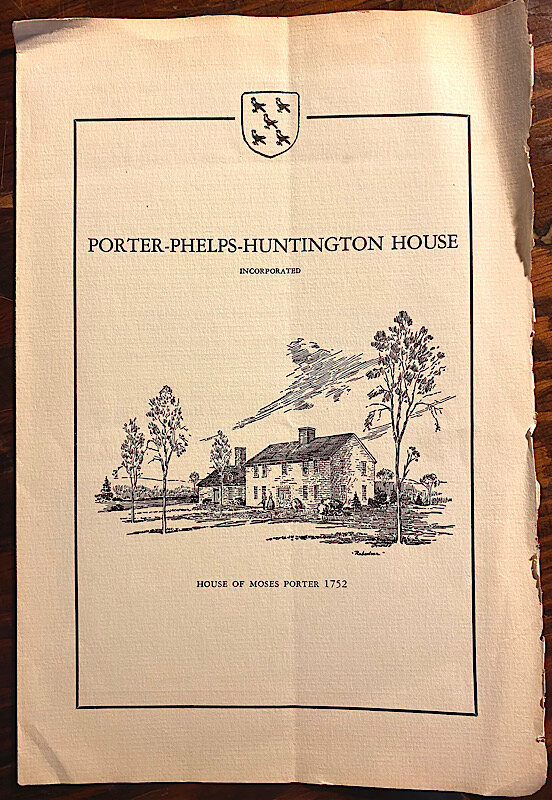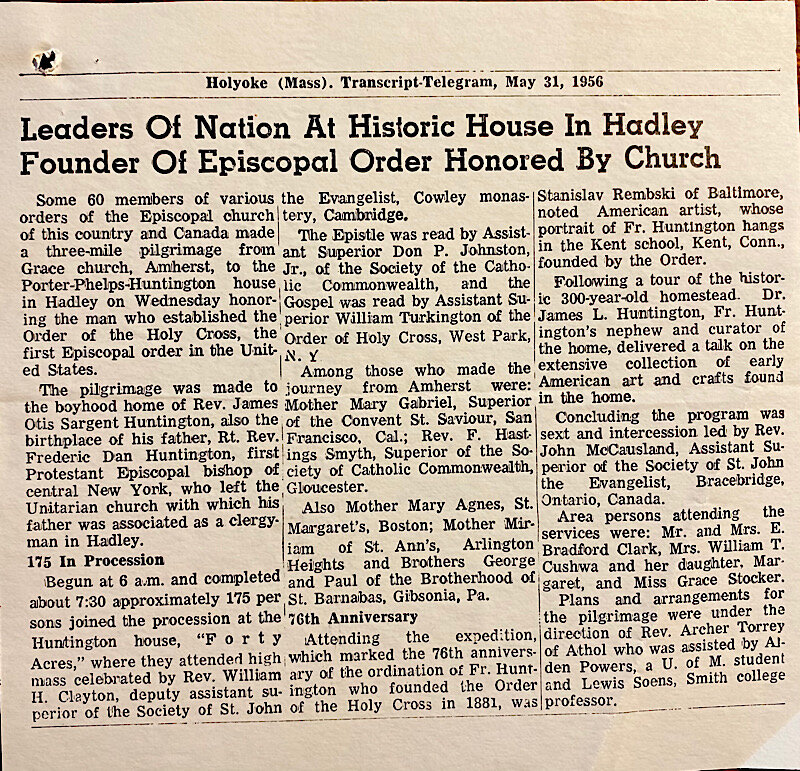Brotherly Conflict and Strong Wills
Amongst the collection of Constant and Gladys Huntington family papers, a folder entitled, “PPH Inc., Sale of Chaise House, Correspondence with Constant & James” was immensely beneficial for documenting the early history of the Porter Phelps Huntington House Museum. Although the folder’s title refers only to brothers James and Constant, correspondence between the two men is but a small piece of the complicated puzzle pertaining to the Museum’s early years.
In the letters between brothers Constant and James, the conflict between them is made clear. Upon the death of their father, George Putnam Huntington and grandfather, Frederic Dan Huntington on the same day in July of 1904, the property of Forty Acres was passed to George’s wife, Lily St. Agnam Barrett Huntington. Upon her death in 1926, the property was split evenly amongst the six children. All six siblings, Henry Barrett, Constant, James, Michael Paul, Catharine and Frederic Dane were each given one-sixth ownership of Forty Acres. This equal division lasted until 1929, when James acquired a total of five-sixths of the property ownership by buying out his siblings, all except Constant. Shortly thereafter, James and his Northampton legal representation, William E. Dwyer Sr. drafted a Deed of Release to the property on June 27, 1929, of which Constant explained: “My share became his immediate property subject to my right of residence for life. I did not like this loss of ownership but I was far away and I wanted to be helpful so I consented. The deed is recorded in the Hampshire County Registry of Deeds, Book 857, page 388.” A Deed of Release is a legal document that removes a previous claim to an asset - in this case, Constant’s claim to the family property of Forty Acres. Years later, in April of 1955, Constant recalled that he “asked to execute papers at once giving my share to [James] and [his] heirs, on my death.”
1949 Advertising Brochure
Printed & distributed one year after the incorporation of the Porter-Phelps-Huntington House.
Constant’s correspondence with Prescott Huntington, a cousin of the brothers and a practicing lawyer in New York, began on July 15, 1954 with Constant requesting: “May I consult you about the Huntington House in Hadley? It is now in the possession of my brother, Jimmie. He is 74 years old, and if he were to die it would go to his second wife, who was a telephone operator in Amherst - an Irish Roman Catholic, much younger than himself.” Constant’s unsavory opinion of a younger, working-class Irish Roman Catholic woman could not change the fact that Genevieve Huntington would inherit Forty Acres upon James’ death.
It was Constant’s hope that James would “part with any of his ownership of the family place at Hadley.” Constant wanted to be “the absolute owner of one-third of the land and buildings, [James] would own the contents outright.” The goal of obtaining one-third ownership would prevent James from selling the property “without [his] consent.” Constant worried that the property would be sold to a non-family member, and the value (both nostalgic and historic) of the eighteenth-century homestead cherished by the family would be lost. Prescott advised Constant that his goal of obtaining one-third ownership of the family property would be complicated by many factors: Constant was not physically present in Hadley, the property ownership was originally split evenly between family members, the property was involved in the incorporation of the Porter Phelps Huntington House, and finally the property’s "$6,000 mortgage.”
Undeterred by the 1929 Deed of Release, Constant’s efforts to maintain influence over the family property continued. His efforts to obtain one-third ownership of the property eventually transformed into an effort to simply maintain enough of a claim to the property and contents in order to prevent a potential sale. James’ dire financial situation led him to place the $6,000 mortgage on the property, but James was unwilling to accept Constant’s offer of $5,000 in exchange for an increased ownership in the house and land. Another conflict between the brothers arose in May of 1955, when Constant was made aware of James’ plans to hold an auction of the contents of the Chaise House on June 4th. In strong opposition to selling any of the family’s private possessions, especially the furniture, Constant wrote to Prescott on June 6, 1955 and included documents in hopes “that it establishes my original ownership of one-sixth of the contents… I have not parted with any of my interest in contents, house or land.” His concern regarding the auction of the contents of the Chaise House was the “Regency Settee” and the “Empire Sideboard,” also referred to as the “Sargent Sideboard.” Constant claimed ownership of these furniture items and that they were simply “on loan” to James and the Museum. Once aware of his sister Catharine’s purchase of the sideboard, Constant writes, “it is perfectly satisfactory if Catharine has bought the Sargent sideboard. She and Alfreda and I only want to preserve house, contents and land for the benefit… of younger generations.”
As well as auctioning items from the Chaise House in June 1955, James’ fundraising efforts for the Museum materialized in other ways. Chairman Elsa P. Brown recorded the minutes of the Committee on Maintenance meeting led by James on November 3, 1956. “6,000 copies of the new picture brochure - “Forty Acres”, 100 posters, a new road sign and other items designed to inform the public of the historic house were financed. During the past summer there has been a 50% increase in visitors to the house. New memberships and contributions to the maintenance fund are enthusiastically received and urgently needed, as always.”
Minnie Ryan Dwight, co-publisher and editor of the Holyoke Transcript-Telegram with her husband William Dwight Sr., was a founding incorporator and life member of the Porter-Phelps-Huntington House until her death in 1957.
Possibly a catalyst for the increased traffic to the Museum occurred in May of 1956, when a “monastic pilgrimage” was held on Memorial Day weekend. The procession of clergy and community members from Grace Episcopal Church in Amherst to the Porter Phelps Huntington House was held in honor of Bishop Frederick Dan Huntington, founder of Grace Church, and his son Rev. James Otis Huntington, founder of the Order of the Holy Cross.
Fundraising efforts over the next few years became more creative and community-based. In 1958, Forty Acres hosted a “fashion show” of historic gowns from the collection donated by Catharine Huntington, and two musicals were put on in the shed by students from the Music Department at Smith College. Wider exposure assisted the Museum’s public relations in October of 1958 when Life Magazine’s coverage of the home and its notorious ghost stories was published shortly before Halloween. However, the income received by the Museum originated then, as it does now, from the generosity of the community, both in business contributions and personal donations.
Interested in supporting the Porter-Phelps-Huntington Museum today with a donation? Click here: https://www.pphmuseum.org/donate
Interested in Bishop Frederick Dan Huntington? Check out the Museum’s blog post on the fourth generation at Forty Acres: https://www.pphmuseum.org/leisure-and-image
Resources
Constant Huntington Family Papers: July 15, 1954; August 5, 1954; August 11, 1954; November 11, 1954; April 9, 1955; May 26, 1955; June 3, 1955; June 6, 1955; August 1, 1956; November 3, 1956; December 28, 1956.
The Berkshire Eagle. “Mrs. Dwight Dies at 84, Newswoman for 66 Years.” Pittsfield, MA. August 1, 1957.
Haskell, Arthur C., Historic American Buildings Survey. “Ext. - General View, Looking Northwest. Huntington House, State Route 47, Hadley, Hampshire County, MA.” August 5, 1935. https://www.loc.gov/pictures/collection/hh/item/ma0732.photos.079652p/
Holyoke Transcript - Telegram. “A Saga of Free Faith in the New England Way.” Holyoke, MA. May 31, 1956.
Holyoke Transcript - Telegram. “Leaders of Nation at Historic House in Hadley, Founder of Episcopal Order Honored By Church.” Holyoke, MA. May 31, 1956.
Porter-Phelps-Huntington Foundation, Annual Reports 1949-1969.


